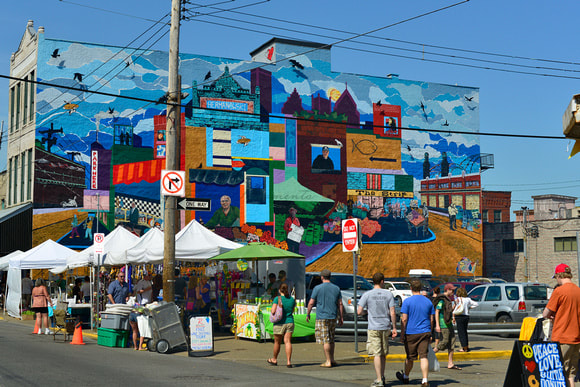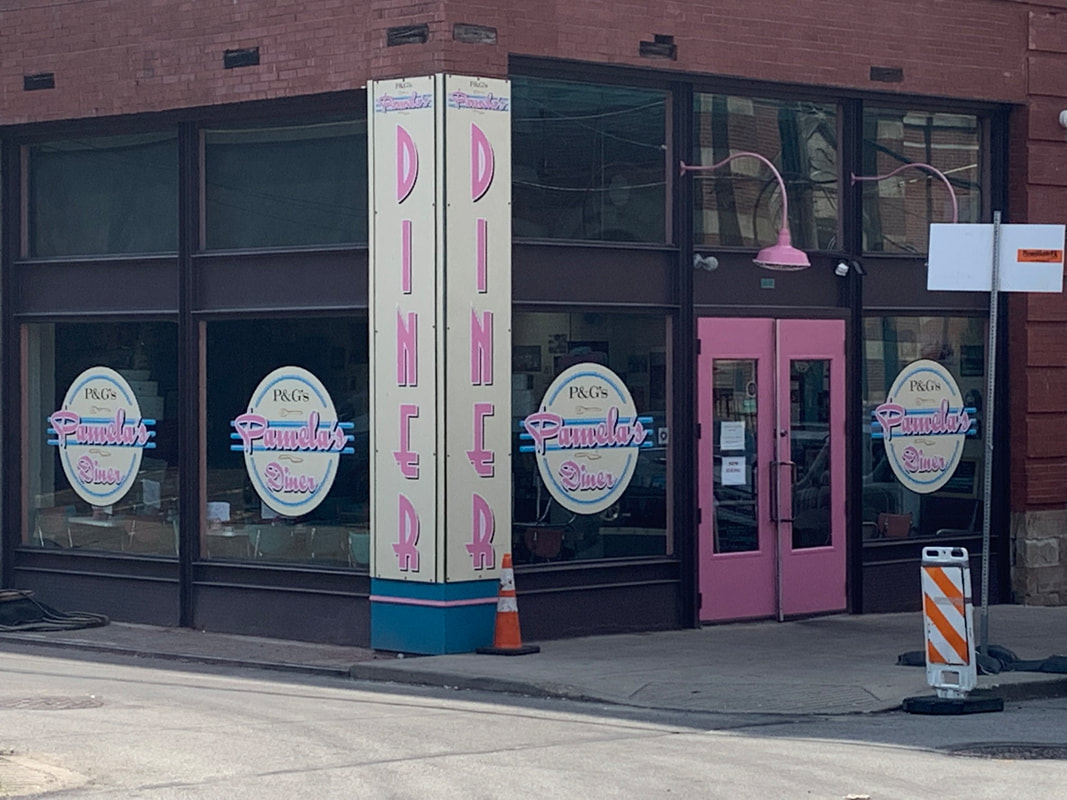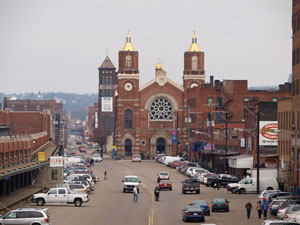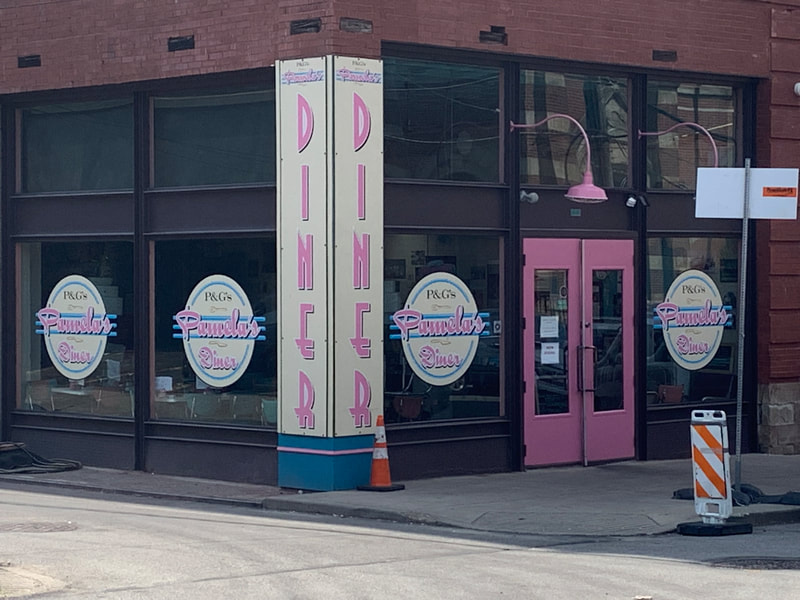|
Content by Nolan Carney
The Strip District in Pittsburgh is one of the city’s most unique neighborhoods. What started out as a hub for the blue-collar workers has morphed itself into one of the most modish spots in the area, which is truly parallel to the City of Pittsburgh as a whole. According to DiscovertheBurgh.com, the area stretches along the banks of the Allegheny River, from 33rd Street to the David L. Lawrence Convention Center on 11th Street. The Strip District is quite the melting pot: populated with different churches, restaurants, and local businesses. From eating to hanging out with friends, current residents know that there is always something new and exciting to do in the area.
|
Many of the buildings in the Strip District are works of art in and among themselves, like this one on Penn Ave and 20th Street.
Photo courtesy of Visit Pittsburgh |
|
Photo courtesy of Penn Live
|
HistoryThe area was first developed in 1814 by George A. Bayard and James O’Hara, but would not officially become Pittsburgh’s 5th Ward until 1837. At that time, it was commonly referred to as Bayardstown, and became the first addition to Pittsburgh’s original 4 Wards. The Strip District was settled in the land between the Allegheny River and the area’s major railroad system, and served as Pittsburgh’s gateway to the North-East. This made it the perfect place for industry, as it was easy to ship goods all across the country. Westinghouse, U.S. Steel, H.J. Heinz, and the Pittsburgh Reduction Company (later ALCOA) all set up production in the Strip District. The Polish, Irish, and German population skyrocketed as workers from overseas poured in to meet the labor demand of these companies. The US Census indicates that in 1910 Pittsburgh was the nation’s 5th largest city, with 26 percent of its population being foreign born. With a large proportion of Pittsburgh’s factory and warehouse jobs located in the Strip District, it wasn’t long before immigrant cultures and traditions began to give the region its identity. Immigrants changed the landscape of the region, and this is still seen today through the area’s food, architecture, and customs. Because of places like the Strip District, Pittsburgh as a whole developed a reputation as a blue collar haven where many chased the American Dream.
|
Food and DrinkOne of the most exciting aspects about the Strip District today is its food scene. From Polish delis to Mexican taco stands, whatever you are craving can be found within the main streets of the Strip. The blue collar history of the Strip meant that residents often had to wake up early and rush to work, with little time to make coffee or breakfast. With that in mind, its easy to see why a breakfast battle of sorts divides residents, with DeLuca’s, Kelly-O’s, and Pamela’s diner offering food that has patrons literally lined in the street. Each diner offers large portions of classic American breakfast fare, as well as some unique menu items, like DeLuca’s ‘Super Bowl’ omelete (kielbasa, mashed potatoes, sauerkraut) or Pamela’s ‘Pam’s Trash Hash’ (potatoes, sloppy Joe meat, bacon, and jalapeno). If breakfast isn’t your cup of tea (pun intended), check out Luke Wholey’s Wild Alaskan Grille. Luke Wholey’s is home to some of the best seafood in the city, and is frequented by the area’s professional athletes and celebrities. And speaking of celebrities, one of the city's biggest has called the Strip its home since 1933: the Primanti sandwich. If you're from out of town and you ask a Pittsburgher where you should eat, odds are you'll hear "Go dahn to Primantis and get yerself a sammich". According to their website, Primanti Brothers started out as small sandwich cart that opened during the Great Depression, serving colossal sandwiches from 3am to 3pm. The idea was to turn the whole meal into a sandwich, so that it was quick to make and easy for the truck drivers to take on the road. The sandwiches include meat, french fries, coleslaw, tomato, and cheese in between two slices of thick Italian bread. They soon moved into a storefront on 18th and Smallman Street, which is still there today, along with seven other locations. Stop in and chose between over 20 different "sammiches," as a true Yinzer would say. But if you decide to stay in and cook, the Strip District also features 13 different grocery stores and food markets. There’s a Polish deli, Korean supermarket, Mediterranean specialty store, and two Italian groceries, just to name a few. There is also plenty of local food shops; a butcher, produce market, fish market, and even a beef jerky outlet! If local business is your thing, stop into Pennsylvania Libations and pick up a bottle of locally crafted liquor or wine. Their website boasts the largest assortment of craft libations in the state of Pennsylvania. And when day turns to night, there’s no shortage of bars in the Strip District. If you can’t decide where to go after a walk down Penn Avenue and Smallman Street, try Ciopinno Restaurant & Cigar Bar. They host live music every weekend, offering local talent from many different genres. Ciopinoo is known for variety, with over 300 types of whiskey, 200 different bottles of wine, and more than 50 cigars to choose from. Whether there’s a cause for celebration, or you are just looking for a night out, the Strip is one of Pittsburgh’s best places to go.
|
Pamela's Diner on 21st Street has a reputation as one of Pittsburgh's best diners.
The storefront of Luke Wholey's welcomes passersby with custom cocktails and appetizers displayed under their blue canopy
|
|
Reyna Foods, a Mexican grocery store, stocks their shelves with everything you need make Taco Tuesday muy magnifico!
The corner of 21st and Penn Ave is a great place to start a weekend in the Strip District
How much is your home worth? |
Shopping and AttractionsNot only does the Strip District offer a wide variety of grocery stores, but the shops on Penn Ave are the perfect place to go for restaurant quality cookware and spices. In the Kitchen is a home store that offers high quality cooking equipment guaranteed to satisfy both the home cook, and the professional chef. With their large array of knives, pots and pans, and kitchen gadgets, it is truly a one stop shop for all types of chefs. Right next store is Penzeys, an outlet that makes and sells gourmet spices. They offer premixed seasonings, as well as individually ground high-quality spices that are sure to add a little something extra to every dish.
When it comes to clothing, the Strip District is home to many unique shops. Anyone seeking out Pittsburgh sports gear should definitely give the Strip a try. The sidewalks are lined with black and gold merchandise, and the abundance of vendors offer a wide variety of prices and quality. The area is only a mile away from PNC Park and Heinz Field, and is a great place to stock up on fan gear before going into the stadiums. The Strip District is an excellent place to spend a Saturday or Sunday. Saturdays 9am-3pm, an artisan market opens on the corner of 20th Street and Penn Avenue. Local vendors fill in the garage, selling different art pieces and craft items. Sellers can vary from week to week, but typically they feature local art, jewelry, food, and craft candles. If you are lucky, the space may feature the adorable dogs from Furkid Rescue, who love to play with and meet new people. At the far end of the Strip District lies the Heinz History Center, a museum featuring both local Pittsburgh artifacts as well as traveling exhibits from the Smithsonian’s collection. It also houses the Western Pennsylvania Sports Museum, which showcases the rich history of the area’s athletics. After the museum, you can continue learning about the culture of the region at the Pittsburgh Opera House. Located on Liberty Avenue, the Opera House sits in an original George Westinghouse Air Brake factory. The Pittsburgh Opera hosts events all over Western Pennsylvania, but many of their best shows can be seen at their location in the Strip. |
What's to come?With young business owners moving into the area, Strip District is seeing a boom in new residential homes and apartment buildings. At the start of 2018 the Cleveland based NRP Group began leasing one and two bedroom apartments at Edge 1909, their building on Waterfront Place. It is right on the river, and is a short walk or drive away from both the Strip District and Downtown. Right up the road from Edge 1909 is Laurel Communities’ Strip District Brownstone project, a series of townhouses ranging in price from $650,000-$1.3 million. As of August 2019, these houses are not yet completed, but the Pittsburgh Post Gazette reports that all 34 townhouses have been presold. More information can be found on their website, Laurelcommunities.com.
On top of new housing products, the Strip District is seeing some of the old beloved buildings being updated for use in the 21st century. The most notable upgrade is the old Produce Terminal on Smallman Street. Built in 1926 by the Pennsylvania Railroad, it was designed as a place where produce could be exchanged between trucks to trains. Chicago based development firm McCaffery Interests began construction in June of 2019, and hopes to once again make the building one of the Strip’s most important sites. They plan on housing local restaurants and other food and produce related operations, as well as expanding parking in the area. This exciting project is set to cost around $50 million, and will add new charm to a classic Pittsburgh building. |
On the left of Smallman Street lies the Produce Terminals
Photo courtesy of Popular Pittsburgh Search Homes for Sale in the Strip DistrictTripAdvisor.com ranks the Strip District as the 5th best place to visit in Pittsburgh. There are no shortage of fun things to do and new places to discover, so it is no wonder they are the only neighborhood on the list! For someone looking to start or expand a small business, the Strip District is one of Pittsburgh’s premier locations. With heavy foot traffic and plenty of new condos and apartments, the area has been cultural mecca since its early days as an industrial pioneer. The Strip District continues to shape the city’s identity, where blue collar roots and traditional restaurants and businesses have adapted into something uniquely Pittsburgh.
The Strip District in Pittsburgh is full of fun things to do, and is one of the best places in the city to discover new cultures through food and art. If you would like to live closer to the action, check out some of the links below!
Make more money when selling your home! |















